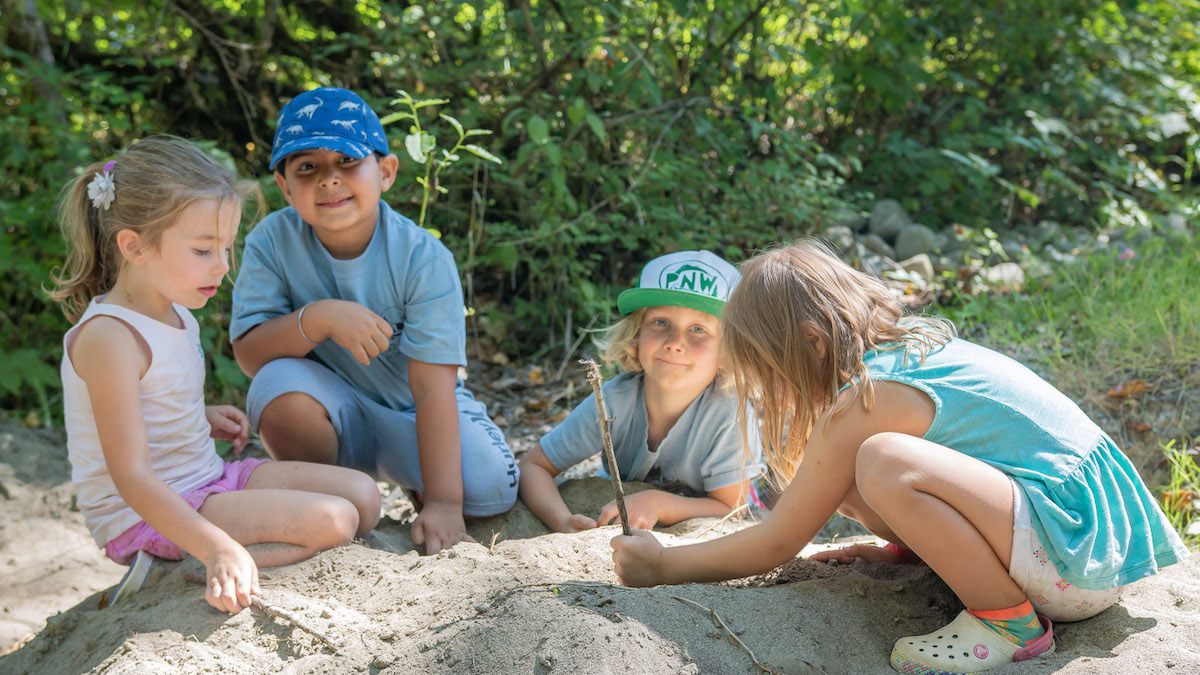It is a fine summer day here in Western Washington, with a slight breeze, singing birds, and flowers and fruit decorating the green world. Schools are out and it’s a great time to take off one’s shoes and head out for a wander.
And do what? What sort of activity might help your child learn about the natural world and have a “productive” day? I would like to propose the fine art of doing nothing.
At Wilderness Awareness School, we certainly offer many activities that children can engage in. Examples from this school year include canoe-making, flint-knapping, primitive fire-making, felting, navigation, developing and presenting a play of a favorite story, making nettle pesto, and so on. One of the more elaborate offerings involved a friendly competition between groups of kids and adults in which they were given slips of paper with the names of all of our local mammals – common names for kids and scientific names for adults. Envelopes with mammal family names were taped to the wall under headings for mammalian orders. The kids and adults then raced to place all of the species names in the correct family envelopes. The first ones done got a bag of chocolate chips, the runners-up got bananas and foil, and they all had the option to make banana boats together. This activity was designed to create a kinesthetic way to learn about a “master list,” which is a list of all of a particular kind of creature living within a designated geographic area.
Cool, right? It was super fun. And yet, when we hear from the kids about their favorite activities at the end of each season, what always stands out is their times of unstructured play. When I first began working as a cultural naturalist-mentor, these swaths of “freeplay” stimulated a little nervousness in me. Wasn’t I supposed to be working? Weren’t they supposed to be learning something? Something in me inherently knew that what was unfolding was rich, deep, and very fun, but I had been acculturated to be uncomfortable with a lack of structure and identifiable outcomes.
Reading Richard Louv’s book Last Child in the Woods: Saving Our Children from Nature Deficit Disorder helped me understand that, actually, some very important things occur when kids play freely in nature, and that this is actually one of the best predictors of environmental stewardship later in their lives.
Louv’s premise fits quite well with Wilderness Awareness School’s methodology that connection is the primary thing to attend to. When children mess around with damming a creek, participating whole-heartedly with mud, sticks, grass, water, stones, and other people, they are connecting, rather than learning abstractly about riparian ecosystems and water quality. They literally are immersed in the fact of frogs, dragonfly naiads, cattails, Caddisfly larvae, Red-Winged Blackbird songs, and crawdads. Their muscles, tendons, and ligaments become educated in the physics of their building substrates as they learn some strategies of Beaver. They practice asserting their ideas while making space for those of others. And they experience the good feeling of effort and accomplishment!
Sometimes they learn about disappointment or even useful boredom, which is a lost art. Boredom certainly isn’t a pleasant feeling, but an expectation of constant entertainment is odd, even in the age of the smartphone. Under the right conditions, such as freeplay time, boredom can result in children’s nervous systems coming down from a continuously stimulated state, allowing them some rest. Coming down to baseline can also help them learn to notice their own impulses towards action, motivation, and creativity.
In considering the benefits of nature freeplay, I recently jotted down this list, which helps me articulate it to those who are new to the idea. Here’s what I’ve observed:
- Imagination
- Self/intrinsic motivation and following passions
- Cooperation
- Collaboration
- Autonomy
- Learning about physics through interaction with the real physical world
- Physical problem-solving
- Common sense
- Inclusivity
- Boundary-setting
- Communication
- Conflict resolution
- Taking healthy risks
- Fine motor skills
- Gross motor skills
- Balance
- Flexibility
- Coordination
- Strength
- Endurance
- Spatial awareness
- Effort and the related good feeling
- Reality-based feedback and natural consequences
- The rhythms of rest/activity, solo/small group/larger group, human/nature
- Self-care
- Accomplishment
- Celebration
- Presentation
- Healthy boredom
- Sensory engagement
- Sensory input that is not human-motivated
- Expanded comfort zones
- Honor system
- Generosity
- Self-esteem
- Sensitivity to beauty
- Caretaking
- Inspired ability to focus
- Service to community (i.e. “I know, let’s make a bridge!”)
- Self-sufficiency
- Planning/sequencing/prioritizing
- Flow state
And freeplay is not just for kids! While it can be restful to just hang out and be an anchor for their play (which is an important role at times) you could also experiment with getting in there and playing alongside them, just following their lead and keeping a light eye on safety. Who knows what might happen if the adults get in there too? Perhaps there could be a study on the benefits for grown-ups, too. I suspect that deep happiness might be a side effect to look out for.
These days, when people ask me what I do, I remember these times of luminous play and I tell them, “My job is to help restore the lost art of childhood.” So it is.
